Abstract
1. We have studied the effects of muscarinic cholinoceptor agonists and specific antagonists on both phasic activity and basal tone of the isolated intravesical ureter of the pig by means of isometric techniques in vitro. 2. Acetylcholine in the presence and absence of physostigmine increased both phasic activity and basal tone of ureteral strips in a concentration-dependent manner. Moreover carbachol, methacholine and oxotremorine-M increased both contractile parameters while bethanechol and McN-A-343 evoked only increases in tone without affecting the frequency of the phasic contractions. 3. The nicotinic receptor blocker, hexamethonium (10(-6)-10(-4) M), failed to modify the contractions evoked by a single dose of carbachol (10(-5) M), whilst the muscarinic antagonist, atropine inhibited both phasic and tonic responses. 4. The muscarinic M1 (pirenzepine), M2 (AF-DX 116 and methoctramine), M3 (4-DAMP, HHSiD and p-F-HHSiD), and putative M4 receptor (tropicamide) antagonists significantly reversed increases in both frequency of phasic activity and baseline tone induced by a submaximal dose of carbachol (10(-5) M). The pIC50 values for inhibition of the induced phasic activity were: atropine (10.16) > 4-DAMP (9.12) > HHSiD (8.22) = methoctramine (7.98) = p-F-HHSiD (7.88 > tropicamide (7.62) = pirenzepine (7.53) = AF-DX 116 (7.45) and for inhibition of basal tone were: atropine (10.73) > 4-DAMP (9.32) > HHSiD (8.65) = pirenzepine (8.43) = p-F-HHSiD (8.38) > methoctramine (7.79) > tropicamide (7.53) > AF-DX 116 (7.04).(ABSTRACT TRUNCATED AT 250 WORDS)
Full text
PDF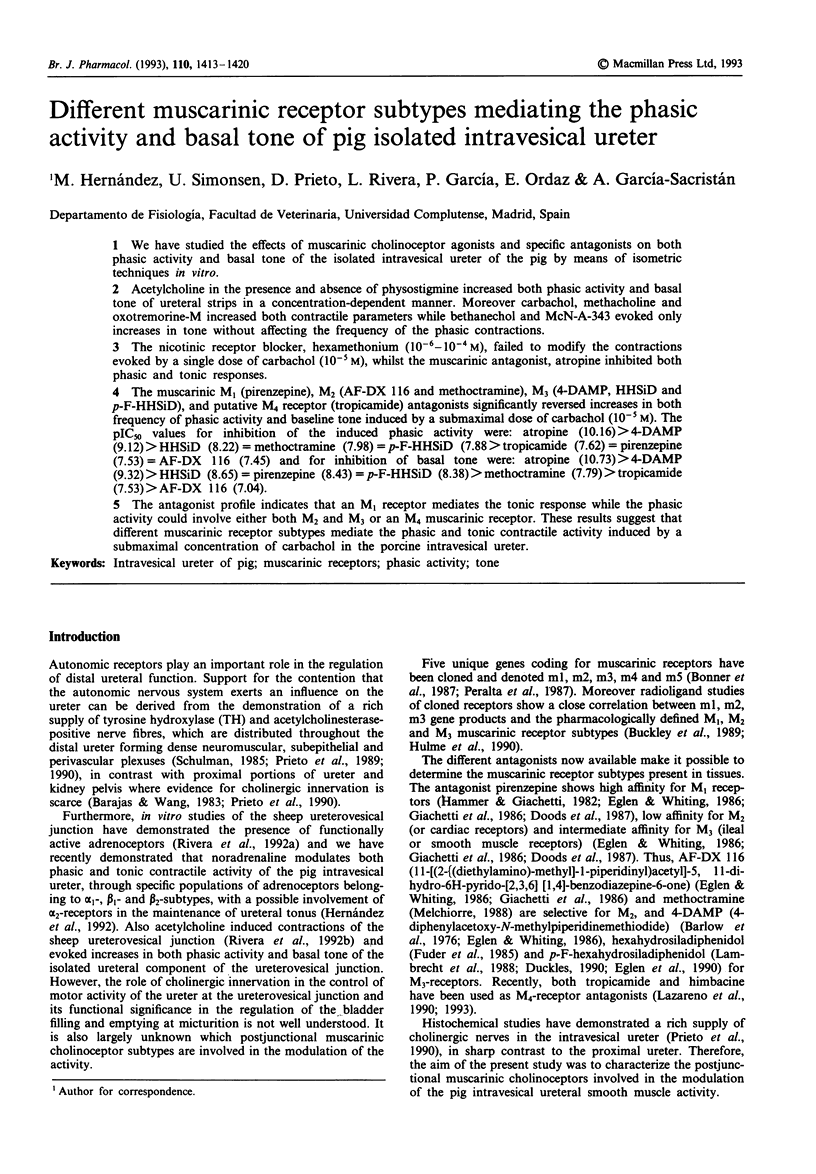
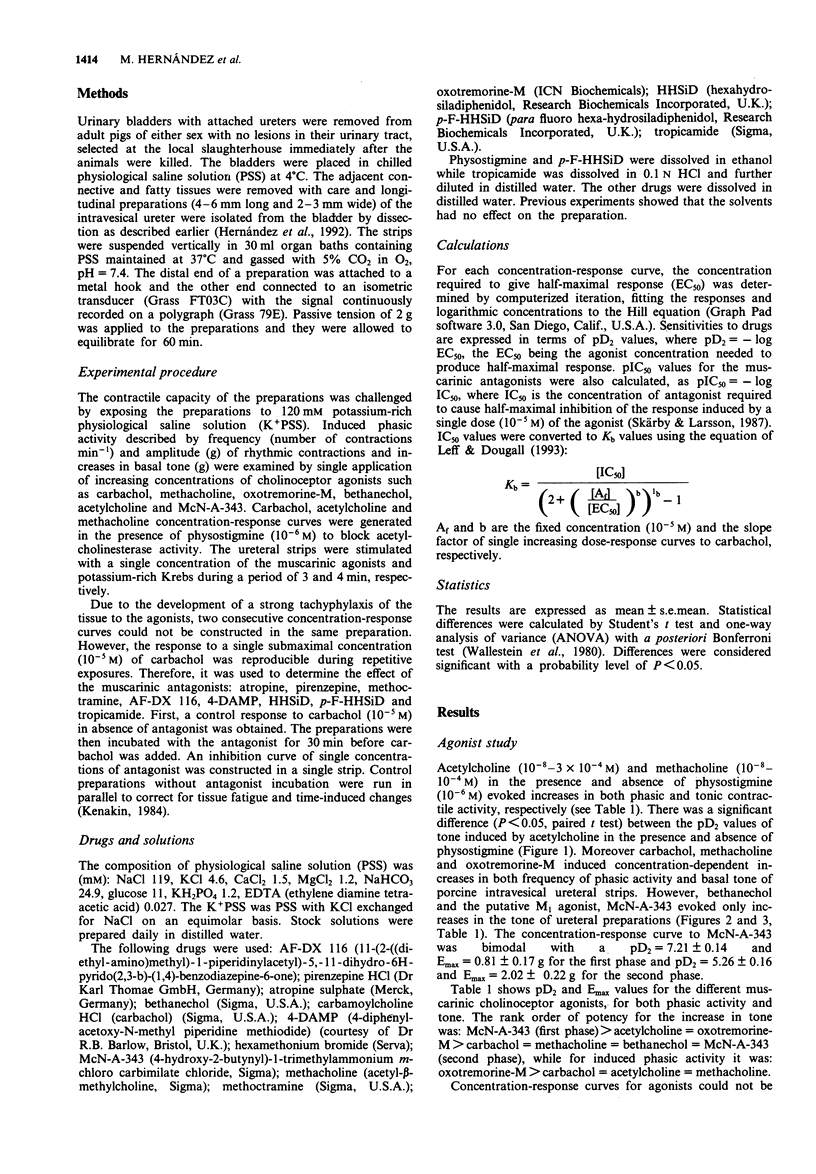
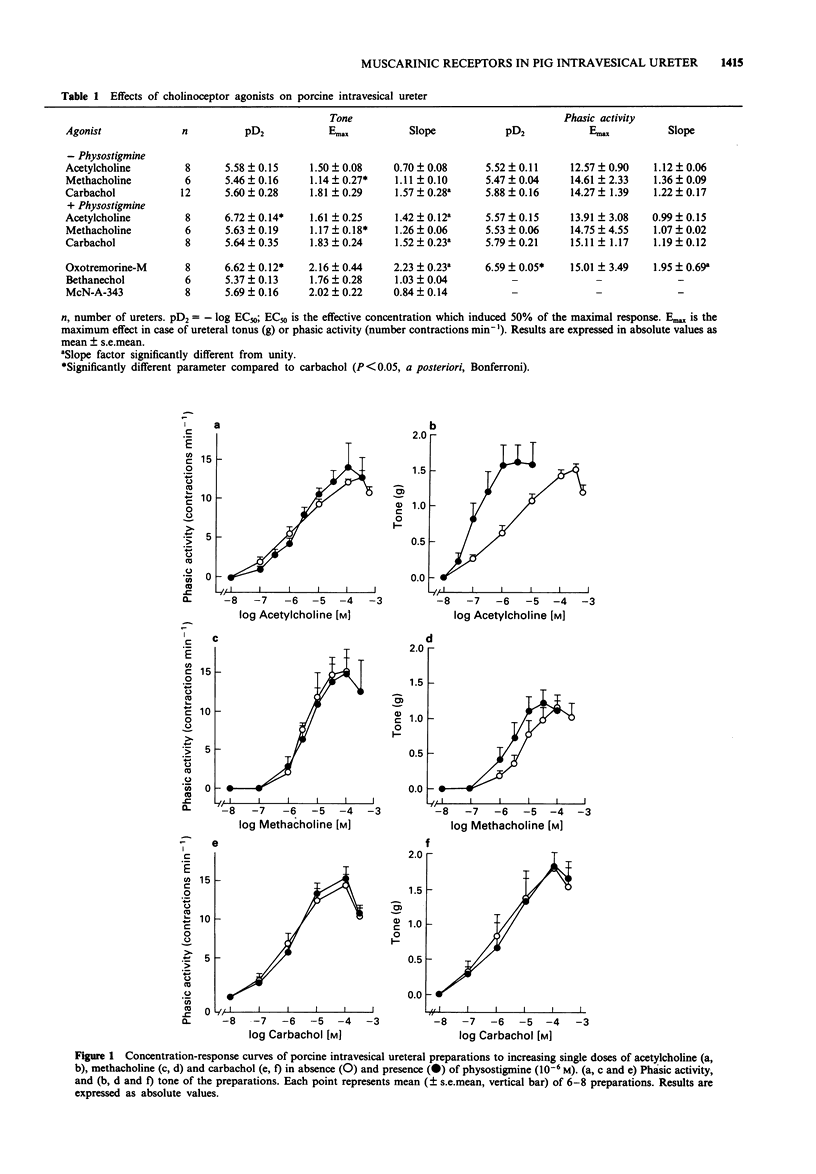
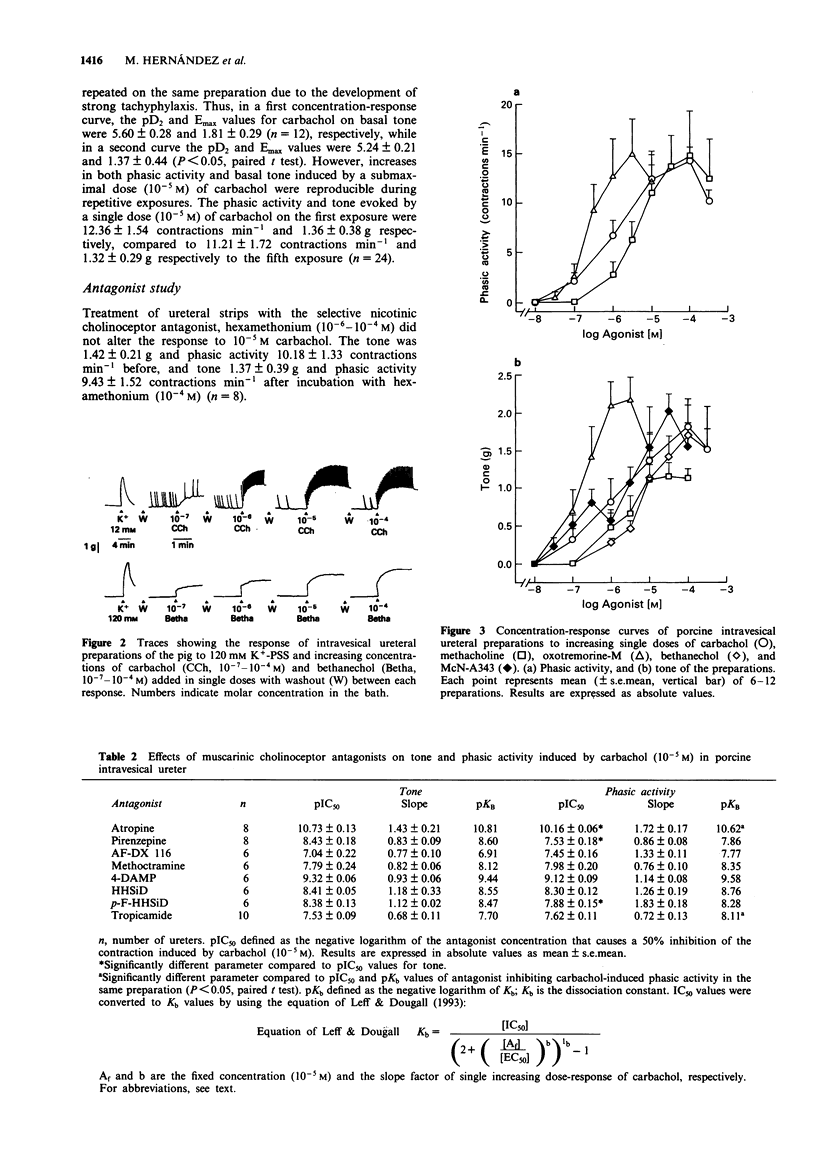
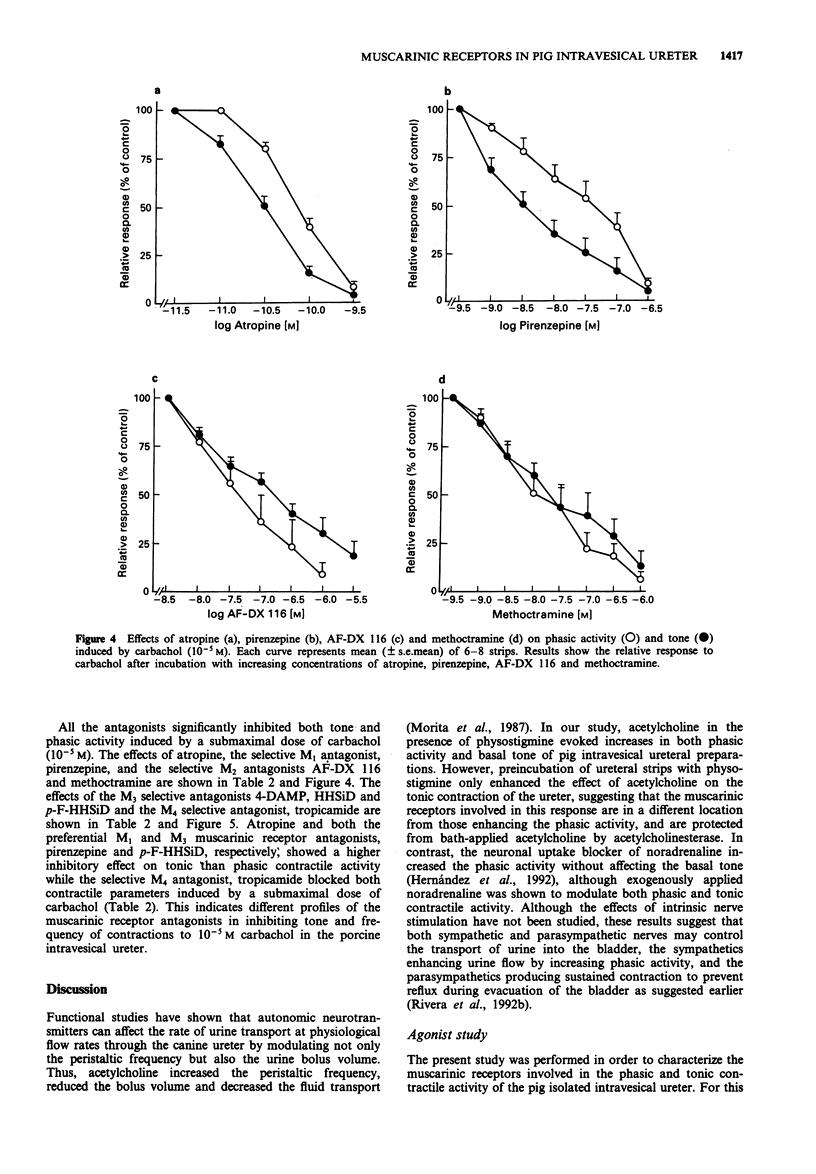
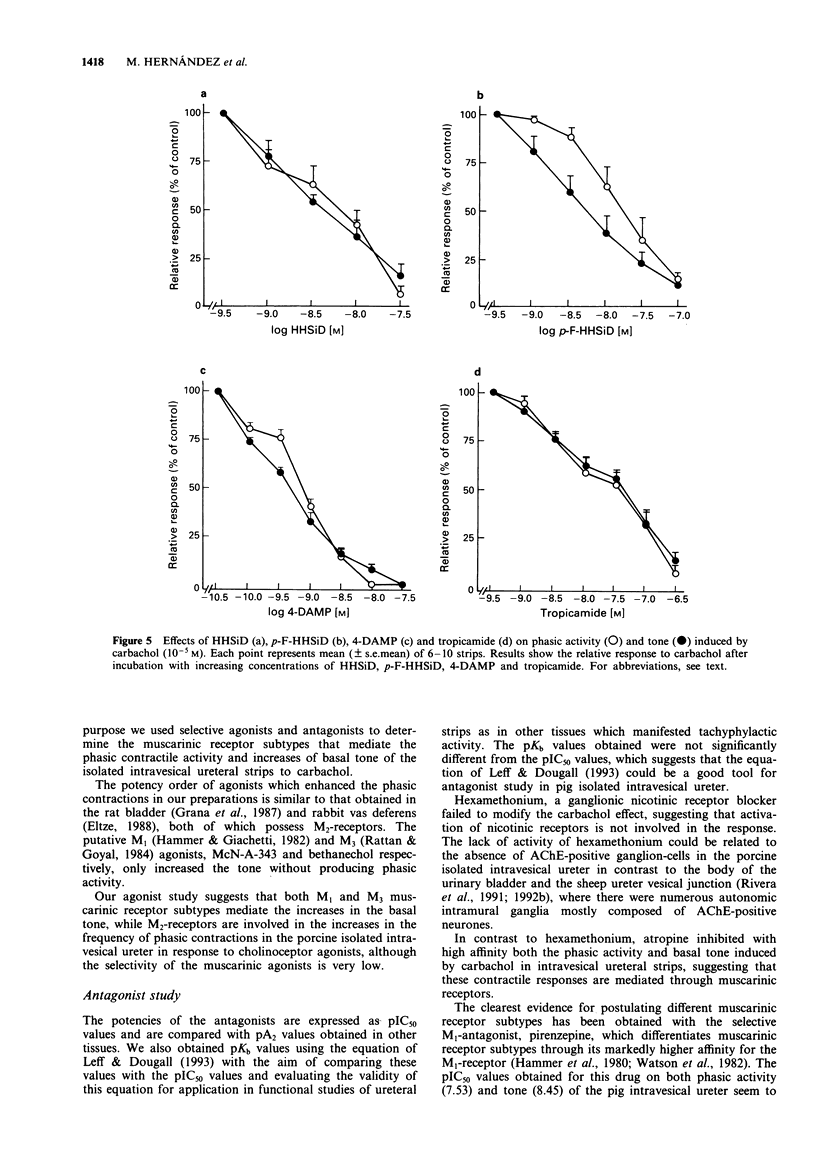
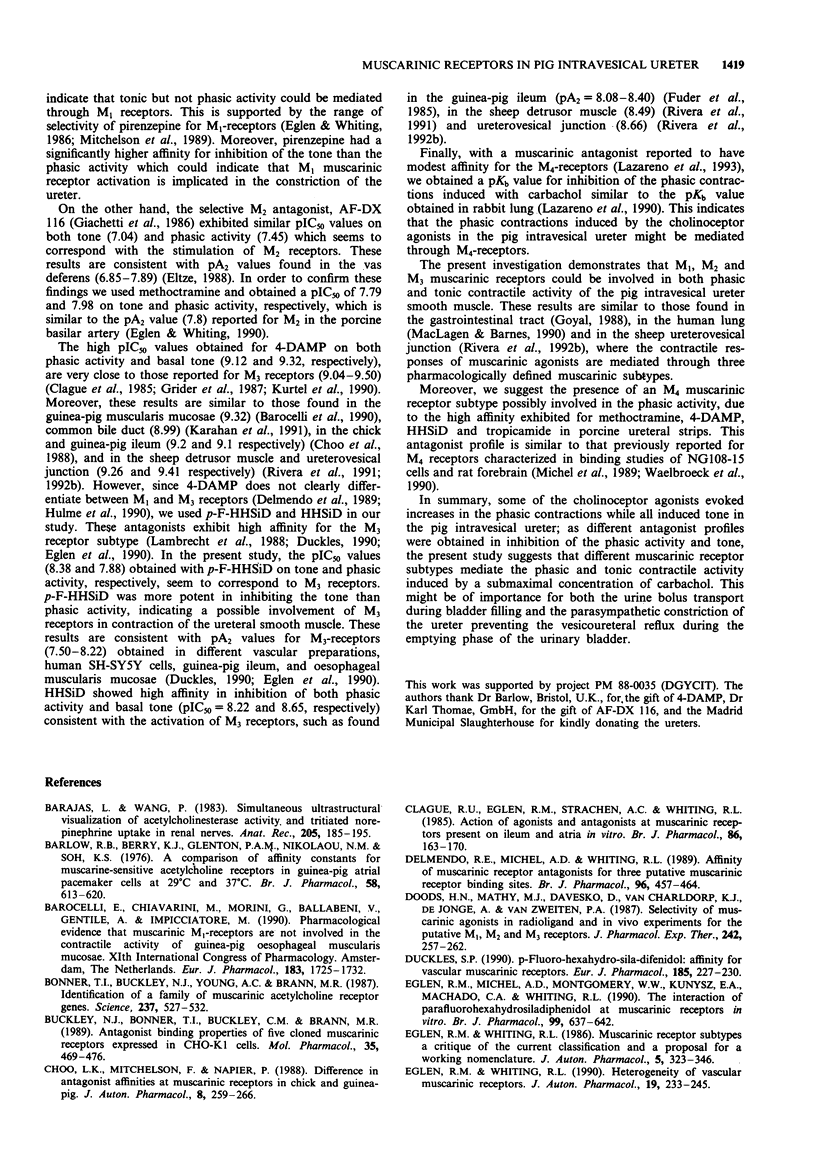

Selected References
These references are in PubMed. This may not be the complete list of references from this article.
- Barajas L., Wang P. Simultaneous ultrastructural visualization of acetylcholinesterase activity and tritiated norepinephrine uptake in renal nerves. Anat Rec. 1983 Feb;205(2):185–195. doi: 10.1002/ar.1092050209. [DOI] [PubMed] [Google Scholar]
- Barlow R. B., Berry K. J., Glenton P. A., Nilolaou N. M., Soh K. S. A comparison of affinity constants for muscarine-sensitive acetylcholine receptors in guinea-pig atrial pacemaker cells at 29 degrees C and in ileum at 29 degrees C and 37 degrees C. Br J Pharmacol. 1976 Dec;58(4):613–620. doi: 10.1111/j.1476-5381.1976.tb08631.x. [DOI] [PMC free article] [PubMed] [Google Scholar]
- Bonner T. I., Buckley N. J., Young A. C., Brann M. R. Identification of a family of muscarinic acetylcholine receptor genes. Science. 1987 Jul 31;237(4814):527–532. doi: 10.1126/science.3037705. [DOI] [PubMed] [Google Scholar]
- Buckley N. J., Bonner T. I., Buckley C. M., Brann M. R. Antagonist binding properties of five cloned muscarinic receptors expressed in CHO-K1 cells. Mol Pharmacol. 1989 Apr;35(4):469–476. [PubMed] [Google Scholar]
- Choo L. K., Mitchelson F., Napier P. Differences in antagonist affinities at muscarinic receptors in chick and guinea-pig. J Auton Pharmacol. 1988 Sep;8(3):259–266. doi: 10.1111/j.1474-8673.1988.tb00189.x. [DOI] [PubMed] [Google Scholar]
- Clague R. U., Eglen R. M., Strachan A. C., Whiting R. L. Action of agonists and antagonists at muscarinic receptors present on ileum and atria in vitro. Br J Pharmacol. 1985 Sep;86(1):163–170. doi: 10.1111/j.1476-5381.1985.tb09446.x. [DOI] [PMC free article] [PubMed] [Google Scholar]
- Delmendo R. E., Michel A. D., Whiting R. L. Affinity of muscarinic receptor antagonists for three putative muscarinic receptor binding sites. Br J Pharmacol. 1989 Feb;96(2):457–464. doi: 10.1111/j.1476-5381.1989.tb11838.x. [DOI] [PMC free article] [PubMed] [Google Scholar]
- Doods H. N., Mathy M. J., Davidesko D., van Charldorp K. J., de Jonge A., van Zwieten P. A. Selectivity of muscarinic antagonists in radioligand and in vivo experiments for the putative M1, M2 and M3 receptors. J Pharmacol Exp Ther. 1987 Jul;242(1):257–262. [PubMed] [Google Scholar]
- Duckles S. P. p-Fluoro-hexahydro-sila-difenidol: affinity for vascular muscarinic receptors. Eur J Pharmacol. 1990 Aug 28;185(2-3):227–230. doi: 10.1016/0014-2999(90)90645-m. [DOI] [PubMed] [Google Scholar]
- Eglen R. M., Michel A. D., Montgomery W. W., Kunysz E. A., Machado C. A., Whiting R. L. The interaction of parafluorohexahydrosiladiphenidol at muscarinic receptors in vitro. Br J Pharmacol. 1990 Apr;99(4):637–642. doi: 10.1111/j.1476-5381.1990.tb12983.x. [DOI] [PMC free article] [PubMed] [Google Scholar]
- Eglen R. M., Whiting R. L. Heterogeneity of vascular muscarinic receptors. J Auton Pharmacol. 1990 Aug;10(4):233–245. doi: 10.1111/j.1474-8673.1990.tb00023.x. [DOI] [PubMed] [Google Scholar]
- Eglen R. M., Whiting R. L. Muscarinic receptor subtypes: a critique of the current classification and a proposal for a working nomenclature. J Auton Pharmacol. 1986 Dec;6(4):323–346. doi: 10.1111/j.1474-8673.1986.tb00661.x. [DOI] [PubMed] [Google Scholar]
- Eltze M. Muscarinic M1- and M2-receptors mediating opposite effects on neuromuscular transmission in rabbit vas deferens. Eur J Pharmacol. 1988 Jul 7;151(2):205–221. doi: 10.1016/0014-2999(88)90801-1. [DOI] [PubMed] [Google Scholar]
- Fuder H., Kilbinger H., Müller H. Organ selectivity of hexahydrosiladifenidol in blocking pre- and postjunctional muscarinic receptors studied in guinea-pig ileum and rat heart. Eur J Pharmacol. 1985 Jul 11;113(1):125–127. doi: 10.1016/0014-2999(85)90352-8. [DOI] [PubMed] [Google Scholar]
- Giachetti A., Micheletti R., Montagna E. Cardioselective profile of AF-DX 116, a muscarine M2 receptor antagonist. Life Sci. 1986 May 5;38(18):1663–1672. doi: 10.1016/0024-3205(86)90410-8. [DOI] [PubMed] [Google Scholar]
- Goyal R. K. Identification, localization and classification of muscarinic receptor subtypes in the gut. Life Sci. 1988;43(26):2209–2220. doi: 10.1016/0024-3205(88)90414-6. [DOI] [PubMed] [Google Scholar]
- Grana E., Lucchelli A., Zonta F., Boselli C. Determination of dissociation constants and relative efficacies of some potent muscarinic agonists at postjunctional muscarinic receptors. Naunyn Schmiedebergs Arch Pharmacol. 1987 Jan;335(1):8–11. doi: 10.1007/BF00165028. [DOI] [PubMed] [Google Scholar]
- Grider J. R., Bitar K. N., Makhlouf G. M. Identification of muscarinic M2 receptors on single muscle cells of the human and guinea pig intestine. Gastroenterology. 1987 Nov;93(5):951–957. doi: 10.1016/0016-5085(87)90556-7. [DOI] [PubMed] [Google Scholar]
- Hammer R., Berrie C. P., Birdsall N. J., Burgen A. S., Hulme E. C. Pirenzepine distinguishes between different subclasses of muscarinic receptors. Nature. 1980 Jan 3;283(5742):90–92. doi: 10.1038/283090a0. [DOI] [PubMed] [Google Scholar]
- Hammer R., Giachetti A. Muscarinic receptor subtypes: M1 and M2 biochemical and functional characterization. Life Sci. 1982 Dec 27;31(26):2991–2998. doi: 10.1016/0024-3205(82)90066-2. [DOI] [PubMed] [Google Scholar]
- Hernández M., Prieto D., Simonsen U., Rivera L., Barahona M. V., García-Sacristán A. Noradrenaline modulates smooth muscle activity of the isolated intravesical ureter of the pig through different types of adrenoceptors. Br J Pharmacol. 1992 Dec;107(4):924–931. doi: 10.1111/j.1476-5381.1992.tb13387.x. [DOI] [PMC free article] [PubMed] [Google Scholar]
- Hulme E. C., Birdsall N. J., Buckley N. J. Muscarinic receptor subtypes. Annu Rev Pharmacol Toxicol. 1990;30:633–673. doi: 10.1146/annurev.pa.30.040190.003221. [DOI] [PubMed] [Google Scholar]
- Karahan F., Alican I., Ozkutlu U., Onat F., Yegen B. C., Ulusoy N. B., Oktay S. Muscarinic receptor subtypes of guinea-pig common bile duct. Arch Int Pharmacodyn Ther. 1991 Jul-Aug;312:140–145. [PubMed] [Google Scholar]
- Kenakin T. P. The classification of drugs and drug receptors in isolated tissues. Pharmacol Rev. 1984 Sep;36(3):165–222. [PubMed] [Google Scholar]
- Kurtel H., Yegen B. C., Dedeoglu A., Ulusoy N. B., Oktay S. Muscarinic receptor subtypes of guinea-pig gallbladder smooth muscle. Arch Int Pharmacodyn Ther. 1990 Nov-Dec;308:39–46. [PubMed] [Google Scholar]
- Lambrecht G., Feifel R., Forth B., Strohmann C., Tacke R., Mutschler E. p-fluoro-hexahydro-sila-difenidol: the first M2 beta-selective muscarinic antagonist. Eur J Pharmacol. 1988 Jul 26;152(1-2):193–194. doi: 10.1016/0014-2999(88)90856-4. [DOI] [PubMed] [Google Scholar]
- Lazareno S., Buckley N. J., Roberts F. F. Characterization of muscarinic M4 binding sites in rabbit lung, chicken heart, and NG108-15 cells. Mol Pharmacol. 1990 Dec;38(6):805–815. [PubMed] [Google Scholar]
- Lazareno S., Farries T., Birdsall N. J. Pharmacological characterization of guanine nucleotide exchange reactions in membranes from CHO cells stably transfected with human muscarinic receptors m1-m4. Life Sci. 1993;52(5-6):449–456. doi: 10.1016/0024-3205(93)90301-i. [DOI] [PubMed] [Google Scholar]
- Leff P., Dougall I. G. Further concerns over Cheng-Prusoff analysis. Trends Pharmacol Sci. 1993 Apr;14(4):110–112. doi: 10.1016/0165-6147(93)90080-4. [DOI] [PubMed] [Google Scholar]
- Maclagan J., Barnes P. J. Muscarinic pharmacology of the airways. Trends Pharmacol Sci. 1989 Dec;Suppl:88–92. [PubMed] [Google Scholar]
- Melchiorre C. Polymethylene tetramines: a new generation of selective muscarinic antagonists. Trends Pharmacol Sci. 1988 Jun;9(6):216–220. doi: 10.1016/0165-6147(88)90089-2. [DOI] [PubMed] [Google Scholar]
- Michel A. D., Delmendo R., Stefanich E., Whiting R. L. Binding characteristics of the muscarinic receptor subtype of the NG108-15 cell line. Naunyn Schmiedebergs Arch Pharmacol. 1989 Jul;340(1):62–67. doi: 10.1007/BF00169208. [DOI] [PubMed] [Google Scholar]
- Mitchelson F., Choo L. K., Darroch S. Muscarinic receptor differentiation. Clin Exp Pharmacol Physiol. 1989 Jun;16(6):523–528. doi: 10.1111/j.1440-1681.1989.tb01599.x. [DOI] [PubMed] [Google Scholar]
- Morita T., Wada I., Saeki H., Tsuchida S., Weiss R. M. Ureteral urine transport: changes in bolus volume, peristaltic frequency, intraluminal pressure and volume of flow resulting from autonomic drugs. J Urol. 1987 Jan;137(1):132–135. doi: 10.1016/s0022-5347(17)43904-8. [DOI] [PubMed] [Google Scholar]
- Peralta E. G., Winslow J. W., Peterson G. L., Smith D. H., Ashkenazi A., Ramachandran J., Schimerlik M. I., Capon D. J. Primary structure and biochemical properties of an M2 muscarinic receptor. Science. 1987 May 1;236(4801):600–605. doi: 10.1126/science.3107123. [DOI] [PubMed] [Google Scholar]
- Prieto D., Benedito S., Rivera L., Hernández M., García-Sacristan A. Autonomic innervation of the equine urinary bladder. Anat Histol Embryol. 1990 Sep;19(3):276–287. doi: 10.1111/j.1439-0264.1990.tb00890.x. [DOI] [PubMed] [Google Scholar]
- Prieto D., Benedito S., Rodrigo J., Martínez-Murillo R., García-Sacristán A. Distribution and density of neuropeptide Y-immunoreactive nerve fibres and cells in the horse urinary bladder. J Auton Nerv Syst. 1989 Jul;27(2):173–180. doi: 10.1016/0165-1838(89)90099-4. [DOI] [PubMed] [Google Scholar]
- Rivera L., Hernández M., Benedito S., Prieto D., García-Sacristán A. Mediation of contraction and relaxation by alpha- and beta-adrenoceptors in the ureterovesical junction of the sheep. Res Vet Sci. 1992 Jan;52(1):57–61. doi: 10.1016/0034-5288(92)90058-a. [DOI] [PubMed] [Google Scholar]
- Rivera L., Hernández M., Benedito S., Prieto D., García-Sacristán A. Mediation of contraction by cholinergic muscarinic receptors in the ureterovesical junction. J Auton Pharmacol. 1992 Jun;12(3):175–181. doi: 10.1111/j.1474-8673.1992.tb00375.x. [DOI] [PubMed] [Google Scholar]
- Rivera L., Prieto D., Hernández M., Benedito S., García-Sacristán A. Distribution and function of cholinergic receptors in the sheep detrusor muscle. J Auton Nerv Syst. 1991 Jun 15;34(2-3):95–102. doi: 10.1016/0165-1838(91)90076-f. [DOI] [PubMed] [Google Scholar]
- Skärby T. V., Larsson B. Theoretical and functional studies on alpha 1-and alpha 2-adrenoreceptors: an examination using the Schild plot. J Auton Pharmacol. 1987 Sep;7(3):185–198. doi: 10.1111/j.1474-8673.1987.tb00148.x. [DOI] [PubMed] [Google Scholar]
- Waelbroeck M., Tastenoy M., Camus J., Christophe J. Binding of selective antagonists to four muscarinic receptors (M1 to M4) in rat forebrain. Mol Pharmacol. 1990 Aug;38(2):267–273. [PubMed] [Google Scholar]
- Wallenstein S., Zucker C. L., Fleiss J. L. Some statistical methods useful in circulation research. Circ Res. 1980 Jul;47(1):1–9. doi: 10.1161/01.res.47.1.1. [DOI] [PubMed] [Google Scholar]
- Watson M., Roeske W. R., Yamamura H. I. [3h]pirenzepine selectively identifies a high affinity population of muscarinic cholinergic receptors in the rat cerebral cortex. Life Sci. 1982 Nov 1;31(18):2019–2023. doi: 10.1016/0024-3205(82)90041-8. [DOI] [PubMed] [Google Scholar]


